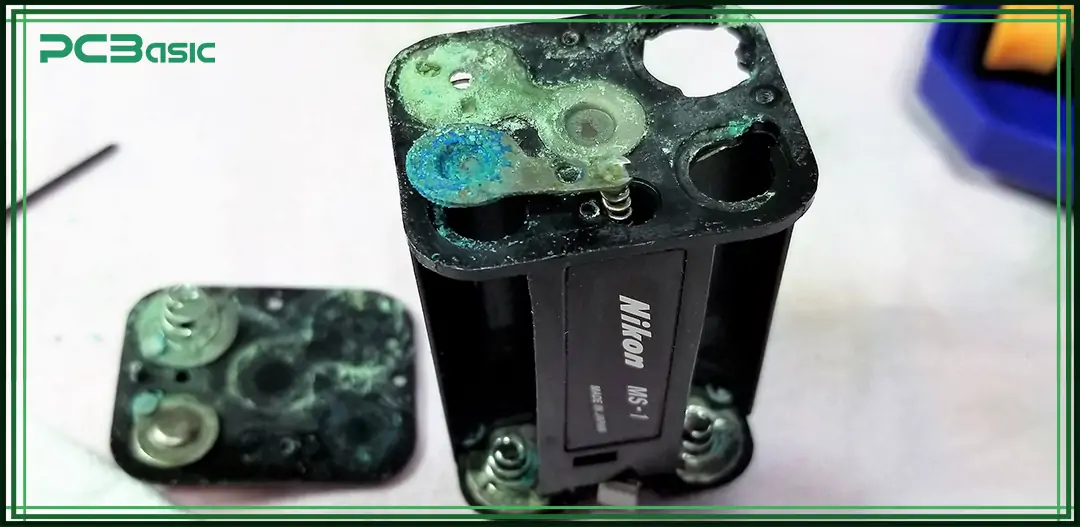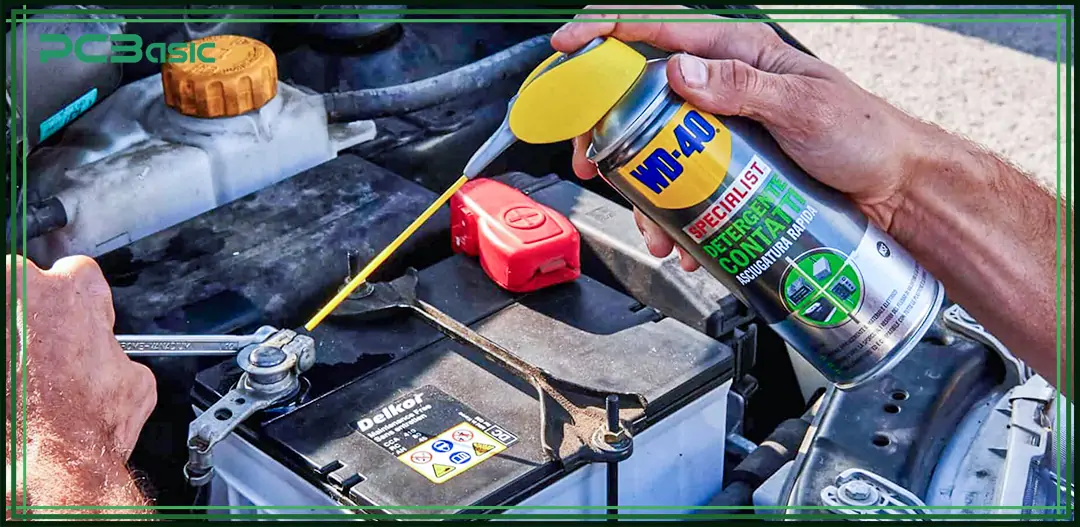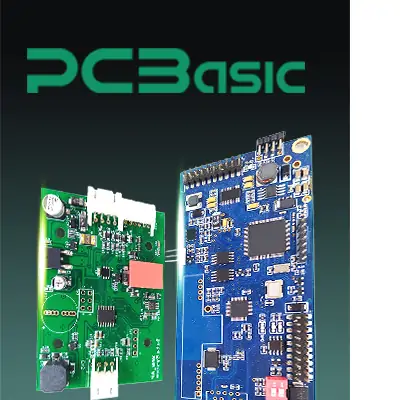

Global high-mix volume high-speed PCBA manufacturer
9:00 -18:00, Mon. - Fri. (GMT+8)
9:00 -12:00, Sat. (GMT+8)
(Except Chinese public holidays)


Global high-mix volume high-speed PCBA manufacturer
9:00 -18:00, Mon. - Fri. (GMT+8)
9:00 -12:00, Sat. (GMT+8)
(Except Chinese public holidays)
HomePage > Blog > Knowledge Base > How to Clean Battery Corrosion by Yourself?
Battery corrosion not only affects the performance of the equipment but may also cause damage. Learning how to clean battery corrosion helps ensure safety and extend the service life of equipment. This article will introduce the causes of battery corrosion, cleaning methods and preventive measures.

Battery corrosion usually appears white, blue-green or gray powdery or crystalline substances near the battery terminals or battery compartments. These substances are formed when the electrolyte inside the battery (mostly potassium hydroxide in alkaline batteries) leaks out and undergoes chemical reactions with moisture, carbon dioxide or other substances in the air. Mastering how to clean battery corrosion helps to remove these harmful residues in a timely manner and protect the safety of the equipment.
Battery corrosion mainly occurs during the process of reaction with the external environment after the leakage of liquid or gas inside the battery. The most common reasons include the following situations:
• Overcharging: When a battery is charged beyond its designed capacity, it can cause excessive gas or heat to be generated in the internal electrolyte, thereby damaging the battery's sealing structure and increasing the risk of leakage.
• Deep discharge: If a battery continues to be used after its power is exhausted, uneven internal pressure may also cause expansion or leakage.
• Age or shelf life expiration: As time goes by, the chemical substances inside the battery will gradually decompose, its sealing performance will decline, and natural aging will occur, making it more prone to leakage.
• Manufacturing defects: Problems such as poor sealing, defects in the shell structure or impurities in the internal materials may cause leakage at an early stage of battery use.
When the electrolyte in a battery, such as potassium hydroxide in alkaline batteries or sulfuric acid in acidic storage batteries, leaks out and undergoes a chemical reaction with moisture in the air, carbon dioxide or the metal materials at the battery's contact points, battery corrosion occurs. These corrosive products not only affect current conduction but also cause irreversible damage to the internal structure of the equipment.
Therefore, understanding the formation mechanism of corrosion helps us take more effective measures, identify problems in a timely manner and master the methods of cleaning battery corrosion to prevent equipment failure.

Here are the safe steps on how to clean battery corrosion:
Mix 15 g of baking soda. Add 240 ml of distilled water. Use a nylon bristle brush carefully. Disconnect the negative (-) terminal using an 8 mm wrench. This solution stops acid corrosion fast. Dab it on spots and leave for 3 minutes. Wash using 500 ml of water at 20°C. Dry with a 120 GSM microfiber cloth.
Tighten bolts to 5.5 N·m torque. Check for grease before connecting. Repeat every 3 months for safety. Baking soda helps clean well. Learn how to clean battery terminals using this mix.
Take 50 ml of vinegar (5% acid). Disconnect the negative terminal first. Use a lint-free cloth to apply. After 4 minutes, scrub with a 0.35 mm steel brush. Rinse using 400 ml of deionized water.
Dry terminals with air at 30 psi. Check resistance under 0.3 Ω with a multimeter. Tighten bolts to 4.5 N·m. Add anti-corrosion spray for better contact. Repeat this every 6 months. Learn how to clean battery corrosion safely using vinegar. It improves conductivity by 18%.
Grate 2 lemons for 60 ml of juice. Loosen the ground cable. Apply juice gently with a polypropylene brush. Wait 5 minutes. Scrub with a copper brush for 2 minutes. Rinse with 300 ml distilled water.
Dry with a 200 GSM cloth. Measure resistance below 0.2 Ω using a multimeter. Add 0.5 mm dielectric grease. Repeat every 4 months. Lemon juice is eco-friendly. Learn how to clean battery corrosion using simple, safe methods.
Spray 10 ml cleaner (80% surfactant) per terminal. Wait 3 minutes. Scrub using a 0.3 mm carbon brush. Wipe with a 140 GSM cloth. Rinse terminals with 250 mL distilled water. Dry with air at 25 psi.
Use a sealant to protect terminals. Check resistance below 0.5 Ω. Tighten bolts to 5.5 N·m torque. Repeat quarterly for heavy buildup. This improves conductivity by 20%. Learn how to clean battery corrosion effectively with a commercial cleaner.
 About PCBasic
About PCBasic
Time is money in your projects – and PCBasic gets it. PCBasic is a PCB assembly company that delivers fast, flawless results every time. Our comprehensive PCB assembly services include expert engineering support at every step, ensuring top quality in every board. As a leading PCB assembly manufacturer, we provide a one-stop solution that streamlines your supply chain. Partner with our advanced PCB prototype factory for quick turnarounds and superior results you can trust.
Wear nitrile gloves (0.15 mm). Use goggles meeting ANSI Z87.1 standards. A PVC-coated apron keeps clothes safe. Use an N95 mask for fumes. Insulated tools like 8 mm wrenches are safer. Use plastic containers for solutions. Replace the gear every 6 months. This reduces chemical risk by 95%. Learn how to clean battery corrosion safely by wearing the right gear.
Use a 0.4 mm steel brush. Scrub the ground (-) terminal first. Move in circles for 2 minutes. Rinse with 500 ml distilled water. Dry with air at 20 psi. Use inhibitor spray for 12% better conductivity. Tighten bolts to 5.5 N·m torque. Measure resistance under 0.3 Ω. Scrub biannually to stop buildup. Learn how to clean battery corrosion with proper scrubbing.
Rinse with 300 ml distilled water. Hold water at a 45° angle. Dry with air at 30 psi. Check for moisture to avoid shorts. Rinse every cleaning session. Store distilled water in sealed containers. Learn how to clean battery corrosion well with this step.
Use a magnifier to check for cracks. Measure resistance below 0.3 Ω. Check wires for damage. Add 0.5 mm dielectric grease. Tighten bolts to 4.5 N·m. Keep positive cables safe. Inspect biannually for efficiency. Record findings for tracking. Learn how to clean battery corrosion while spotting damage early.
• Metal Coatings:
Steel is safe with zinc (Zn) coatings. Zinc adds 75 μm layers. Corrosion stops completely. C5-rated methods work. Large areas need hot-dip galvanization. Coatings stop reactions with chloride (Cl⁻) and sulfate (SO₄²⁻). ASTM B117-19 tests check layers. Know how to clean battery corrosion. Use a baking soda (NaHCO₃) solution to neutralize acid corrosion. Avoid using concentrated sulfuric acid unless under professional supervision. Scrub with brushes. Dry surfaces entirely. This prevents galvanic coupling. Expect 20-year durability. Follow the guidelines always. Metal coatings last longer.
• Non-Metallic Coatings:
Acids with pH 4.0-8.5 need nonmetallic coatings. Epoxy layers reach 75 μm. Use ISO 2409 adhesion tests. Sandblast surfaces. Apply at 20°C with 65% RH. These resist harsh corrosion. Protect trays with polyurethane. Use 200 μm H₂SO₄ barriers. Heat ensures adherence. Cleaning is important. Remove all residues. Prepare carefully. It protects surfaces.
• Chemical Coatings:
Zinc phosphate coatings stop rust. Layers resist oxygen (O₂). Add 10 μm for protection. Phosphates stop chloride ingress. ISO 3613 guarantees durability. Surfaces resist 1,200-hour salt spray. Use 2.5% LiOH grease. Prevent terminal damage. Spread grease evenly. Petroleum jelly blocks acids. Trust these proven steps.
• Electrochemical Protection:
Cathodic systems fight rust. Use Zn or Mg anodes. Voltage must reach 1.1 V. Current is 0.25 mA/cm². Oxidation is blocked. Larger setups need 10-30 V. EN 12496 ensure safety. Prevent battery corrosion with Zn paste. Protect the terminals fully. Keep joints tight. Inspections are vital. Reliable outcomes follow electrochemical use.
• Other Methods of Protection:
SS316 steel resists corrosion. Chromium content is 12%. Adjust designs to avoid pooling. Add 3 mm drain holes. Indoors, RH stays 40%. Store batteries at 5°C-25°C. Inspect every 90 days. Remove K₂CO₃ residues quickly. Anti-corrosion mats stop spilling. Always follow the exact steps.
|
Protection Type |
Material Used |
Layer Thickness |
Resistance Level |
Durability Rating |
Testing Standards |
|
Metal Coatings |
Zinc (Zn), Chromium |
50–75 µm |
High (C5 classification) |
20+ years |
ASTM B117-19 |
|
Non-Metallic Coatings |
Epoxy, Polyurethane |
75–200 µm |
Medium |
15–20 years |
ISO 2409 adhesion testing |
|
Chemical Coatings |
Zinc Phosphate, LiOH |
10 µm |
Extreme (1200 hours) |
25+ years |
ISO 3613-certified durability |
|
Electrochemical Protection |
Zinc (Zn), Magnesium (Mg) |
Varies with setup |
Voltage 1.1 V |
10–15 years |
EN 12496 cathodic criteria |
|
Other Methods |
Stainless Steel (SS) |
- |
Moderate |
10–12 years |
RH 40% stability for longevity |
Table on How to Protect Metals from Corrosion!
Q1: Can Corroded Batteries Be Fixed?
A1: Yes, they can! First, disconnect cables using a 10 mm wrench. But don’t forget to wear 0.3 mm gloves for safety. Then, mix 15 g baking soda with 250 mL water. After that, apply the paste to corroded parts.
Next, scrub using a 1.2 mm steel brush. Once clean, rinse it off with 500 mL of deionized water. After rinsing, dry it with compressed air at 30 psi. Then, coat terminals with a thin, 0.5 mm dielectric grease layer. To ensure health, test voltage monthly. Ideally, it should stay between 12.4V and 12.8V.
Regular cleaning, paired with these checks, prevents early battery failures. For a better understanding, you can search "how to clean battery corrosion" online. Reliable tools and supplies make this process easier.
Q2: How Often Should I Check My Battery For Corrosion?
A2: To stay safe, inspect batteries every 90 days. Start by checking for white (PbSO₄) or blue (CuSO₄) deposits. Then, measure voltage with a 200 µA accuracy multimeter. If deposits are visible, disconnect cables with an 8–10 Nm torque wrench. Afterward, mix 10 g of baking soda with 250 mL of water.
Use this mixture to clean deposits. Next, scrub with copper bristles at 120 rpm. Once scrubbed, rinse with 500 mL distilled water. But make sure to dry everything completely.
Additionally, test insulation using a megohmmeter with a 100 MΩ range. To protect connectors, use anti-corrosive sprays, especially those with 30% zinc oxide. By doing this, batteries stay in top condition longer. So, remember to follow these steps and learn "how to clean battery corrosion" for better care.
Q3: Is Battery Corrosion Dangerous To Touch?
A3: Yes, it is harmful. For one, PbSO₄ irritates the skin and eyes. This happens whenever voltage exceeds safe limits. On top of that, H₂ gas builds up at 4% air concentration.
To stay safe, always wear 0.3 mm thick gloves. Also, use EN 166 goggles to protect your eyes. Then, mix 15 g baking soda with 200 mL water. Use this to neutralize corrosion safely.
Afterward, scrub it off with a 0.3 mm stainless steel brush. Once done, rinse the area with 500 mL of distilled water. After rinsing, dry it with air at 40 psi. Finally, waste should be disposed of as hazardous material. By following these steps, you reduce risks.
Q4: Does Corrosion Mean I Need a New Battery?
A4: Not always! While corrosion looks bad, it doesn’t mean you must replace the battery. Instead, disconnect terminals using insulated pliers rated 1000V. Then, mix 10 g of baking soda with 150 mL of water to make a paste. Apply the paste to the corroded terminals.
After that, scrub using a 1 mm carbon steel brush. Once clean, rinse it thoroughly with 500 mL of distilled water. Then, dry it completely before applying dielectric grease in a 0.5 mm layer.
Afterward, test voltage using a 100 A load tester. If it drops below 12.4V fully charged or 10.5V under load, you’ll need to replace the battery. Otherwise, proper maintenance extends its life significantly. So, always follow reliable steps to keep batteries working well.
Corrosion hurts batteries. You can clean this. Learn how to clean battery corrosion today. Cleaning keeps them safe. Use PM100 for help. Protect your batteries now! Discover more at PCBasic!

Assembly Enquiry
Instant Quote
Phone contact

+86-755-27218592
In addition, we've prepared a Help Center. We recommend checking it before reaching out, as your question and its answer may already be clearly explained there.
Wechat Support

In addition, we've prepared a Help Center. We recommend checking it before reaching out, as your question and its answer may already be clearly explained there.
WhatsApp Support

In addition, we've prepared a Help Center. We recommend checking it before reaching out, as your question and its answer may already be clearly explained there.
